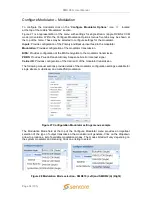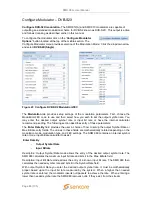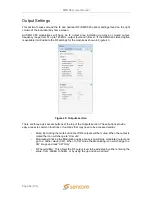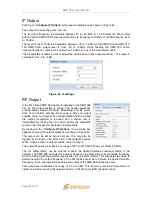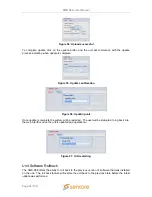
SMD 989
– User Manual
Page 47 (105)
Sync Byte Deletion:
The Sync
Byte Deletion advanced feature permits removal of the incoming
MPEG stream sync bytes from reaching the modulator. so as to not output symbols containing
the sync byte information. This enables a savings in bandwidth of 1 byte every 188 bytes as
modulator output symbols containing sync byte data are removed.
The Sync Byte Deletion setting can be disabled or enabled. When set to Enabled, the modulator
blocks the incoming Sync Byte. When Enabled the receive demodulator must reinsert it. When
Disabled the modulator receives the full transport stream including the Sync Bytes.
Reduced Latency:
The advanced section contains several reduced latency modes which may be applied to the
TurboPSK modulation. The reduced latency modes of the TurboPSK modulation provides several
levels of latency that can be applied. The reduced latency modes are only applicable to special
low symbol rate data satellite applications using the TurboPSK modulation.
Reduced Latency Selections
-
Disabled: (Default) No latency reduction - with additional input buffering
-
Normal: Introduces slight latency without additional input buffering
-
Reduced 1: Adds latency reduction to the Normal mode
-
Reduced 2: Adds latency reduction to the Reduced 1 mode
-
Reduced 3: Adds latency reduction to the Reduced 2 mode
-
Minimum: Adds latency reduction to the Reduced 3 mode
PRBS (Pseudo Random Binary Sequence):
The PRBS feature provides a digital test
signal with known properties used for BERT (bit error rate testing) of satellite equipment
or transmission paths. Test signals used are a binary PN (Pseudo-Noise) signal known
as a PN-23 or Inverted PN-23. The test signal is selected within the PRBS tab/menu.
For BERT tests, the PRBS setting may be set to Enabled. When Enabled, the normal
input signal to the modulator is removed and replaced with the PN-23 or Inv PN-23
signal.
IMPORTANT: For normal or non-testing applications in which the input is to be
used to modulate the satellite IF or L-Band carrier output, the PRBS test signal
must be set to DISABLED.
Figure 40: Reduced Latency Selections


